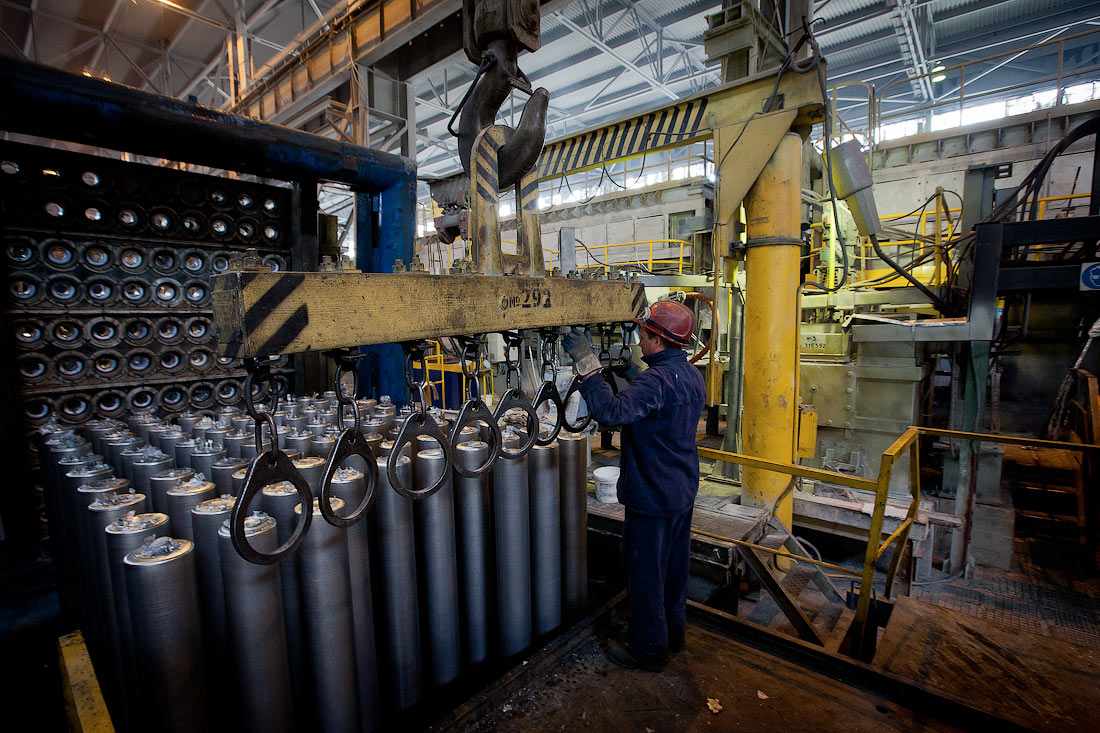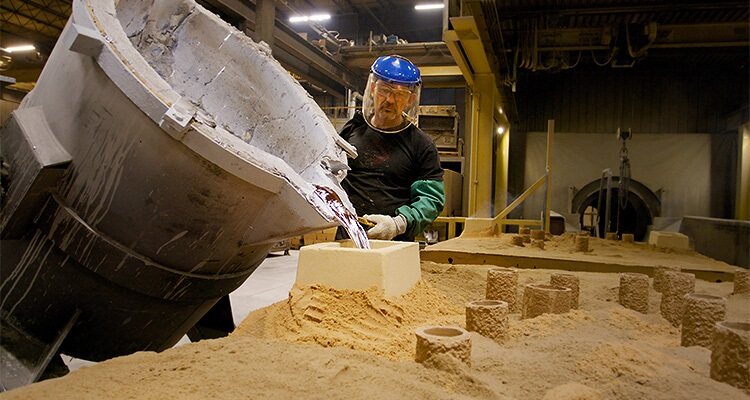How Aluminum Foundry minimizes emissions through sustainable practices
Wiki Article
All Regarding Aluminum Foundry: Key Uses and Its Effect On Item Development
Aluminum foundries are vital in contemporary production, particularly in sectors like automobile and aerospace. They use advanced methods to create light-weight, sturdy elements that enhance efficiency. The convenience of aluminum additionally lines up with sustainability efforts, making it a preferred product. The continuous developments in casting techniques and their ramifications for item advancement raising crucial concerns. What future improvements might reshape the landscape of aluminum foundries and their applications?Review of Aluminum Foundries
Aluminum foundries act as crucial facilities in the metalworking industry, concentrating on the casting of aluminum and its alloys. These facilities make use of different approaches, consisting of sand casting, die casting, and financial investment casting, to change raw aluminum into useful kinds. Each casting strategy uses unique advantages, catering to different job needs ranging from tiny components to huge architectural components.The foundries run with a precise process that starts with melting aluminum, complied with by putting the liquified steel into mold and mildews. After cooling, the castings undertake finishing processes, which might entail machining and surface area therapy to meet accurate specifications.
Quality control is paramount, making sure that the end products meet sector requirements and customer assumptions. On top of that, aluminum foundries commonly emphasize sustainability by reusing scrap aluminum, consequently decreasing waste and saving sources. This commitment to efficient manufacturing and environmental duty positions aluminum foundries as vital factors to the manufacturing landscape.

Key Applications of Aluminum Castings
Aluminum castings serve crucial roles in numerous sectors, especially in vehicle and aerospace markets. In the auto market, they add to lightweight frameworks and reliable efficiency. Aerospace part production counts on aluminum castings for their strength and rust resistance, essential for high-performance applications.Automotive Market Applications
In the vehicle sector, aluminum castings play a critical duty in enhancing automobile performance and effectiveness. These castings are commonly used for parts such as engine blocks, transmission housings, and suspension components. Their light-weight nature contributes to decreased automobile weight, which in turn boosts fuel economic situation and handling. Furthermore, aluminum's exceptional thermal conductivity enables reliable warmth dissipation, necessary for high-performance engines. The rust resistance of aluminum additionally prolongs the life expectancy of automobile parts, decreasing upkeep prices. Moreover, advancements in casting modern technologies enable the manufacturing of complicated forms, maximizing the style and capability of components. Overall, aluminum castings are integral to modern-day automobile engineering, sustaining development and sustainability in vehicle layout.Aerospace Element Production
The aerospace industry significantly relies upon aluminum castings for a variety of critical components because of their helpful buildings. Lightweight yet strong, aluminum castings enhance gas effectiveness and total performance in aircraft design. Parts such as engine installs, structural frames, and landing gear are frequently created making use of aluminum casting strategies, enabling makers to attain complex geometries while maintaining architectural stability. The high resistance to corrosion and thermal residential or commercial properties of aluminum also contribute to the long life and reliability of aerospace components. Additionally, advancements in casting innovations, such as precision casting and 3D printing, have increased the capacities of aluminum in this field. Eventually, aluminum castings play an important role in conference stringent safety criteria and performance demands in modern-day aerospace applications.Advantages of Making Use Of Aluminum in Manufacturing
While various materials are available for production, aluminum attracts attention because of its unique combination of residential or commercial properties that enhance efficiency and efficiency. One substantial advantage of aluminum is its light-weight nature, which contributes to lowered energy usage and boosted gas performance in different applications. Additionally, aluminum exhibits excellent deterioration resistance, expanding the lifespan of items and decreasing maintenance prices. Its high thermal and electrical conductivity makes it ideal for heat exchangers and electric elements, while its malleability enables for versatile layouts and complex forms.Aluminum is recyclable, promoting sustainability in making procedures. This reusability not just preserves resources but also reduces the carbon impact connected with manufacturing. The flexibility of aluminum to different alloys better enhances its energy in varied sectors, from automobile to customer electronics. Collectively, these characteristics make aluminum an ideal selection for manufacturers seeking to stabilize efficiency, cost-effectiveness, and ecological responsibility.
Innovations in Casting Strategies
Recent advancements in casting techniques have greatly transformed the aluminum factory sector. The integration of 3D printing innovation has actually enabled much more complicated styles, while enhanced alloy solutions enhance efficiency and durability. These developments are driving effectiveness and broadening the applications of aluminum in numerous markets.3D Printing Assimilation

Improved Alloy Formulations
Improvements in aluminum factory modern technology have brought about the development of enhanced alloy formulas that boost casting performance and material homes. These cutting-edge formulations often include elements such as silicon, magnesium, and copper, which optimize stamina, ductility, and corrosion resistance. By fine-tuning the compositions, suppliers can achieve specific attributes customized to varied applications, from auto to aerospace sectors. Additionally, these enhanced alloys assist in far better fluidness throughout the casting procedure, lowering problems and enhancing surface area finish. Therefore, the efficiency of manufacturing is significantly enhanced while keeping rigorous top quality standards. This advancement in alloy advancement not only streamlines manufacturing however additionally supports the production of lighter, more powerful components, inevitably progressing product development and performance.Effect on Aerospace and Automotive Industries
The notable impact of aluminum foundries on the aerospace and automotive markets can not be overstated. Aluminum alloys, known for their light-weight and high toughness, have reinvented the design and production procedures in both industries. In aerospace, the reduction in weight directly correlates to fuel effectiveness, enabling longer trips and reduced discharges. Parts such as airplane frameworks, wings, and engine parts gain from aluminum's excellent exhaustion resistance and rust resistance.In the automobile sector, aluminum foundries add to the production of lighter automobiles, enhancing performance and gas economic situation while meeting rigorous environmental regulations. Using aluminum in engine blocks, body panels, and wheels has actually enhanced considerably, driven by consumer need for extra effective automobiles. Additionally, advancements in casting techniques have actually enhanced the accuracy and capability of parts, enabling manufacturers to create more integrated and complicated designs, thus cultivating improvements in both industries.
Sustainability Practices in Aluminum Foundries
Aluminum foundries are significantly welcoming sustainability techniques to lower their ecological footprint while satisfying the expanding needs of the aerospace and vehicle industries. These techniques include the application of energy-efficient modern technologies, such as electrical melting heaters and advanced warmth recovery systems, which substantially lower energy usage (Aluminum Foundry). On click for info top of that, several foundries are prioritizing using recycled aluminum, which requires much less energy and leads to lowered greenhouse gas exhausts contrasted to primary aluminum manufacturingWater preservation initiatives are additionally gaining traction, with foundries using closed-loop systems to decrease water use and prevent contamination. Furthermore, waste administration approaches, consisting of recycling scrap and reducing hazardous waste, add to an extra sustainable procedure. By embracing these practices, aluminum foundries not only boost their competition yet likewise align with worldwide sustainability objectives, inevitably supporting a circular economic climate and fostering technology in eco-friendly manufacturing procedures.
Future Fads in Aluminum Casting Technology
As the need for light-weight and long lasting products proceeds to rise, developments in casting technology are poised to reshape the aluminum market. Advanced methods such as 3D printing and automated casting processes are obtaining traction, enabling for much more intricate geometries and lowered material waste. The integration of expert system and artificial intelligence is also improving quality assurance and process optimization, decreasing flaws and improving effectiveness.The advancement of new aluminum alloys is broadening the application range of cast products, making them ideal for markets from automotive to aerospace. Improved reusing methods are expected to additionally lower environmental effects, straightening with global sustainability goals.
In addition, using wise sensors in casting processes is prepared for to enable real-time tracking, guaranteeing better precision and uniformity. These fads symbolize a useful source transformative age in aluminum casting innovation, making it possible for manufacturers to satisfy evolving market demands while prioritizing sustainability and technology.
Regularly Asked Concerns
How Is Aluminum Recycled After Usage in Products?
Aluminum reusing entails gathering, arranging, and melting utilized aluminum products (Aluminum Foundry). The molten steel is then cast right into brand-new forms, minimizing energy usage and maintaining natural deposits, making it a reliable and lasting procedure for aluminum healingWhat Precaution Are Applied in Aluminum Foundries?
Precaution in aluminum foundries include appropriate ventilation systems, individual safety devices, regular safety and security training, tools upkeep protocols, and emergency feedback plans, all aimed at lessening risks related to high temperatures and harmful products throughout production.Exactly How Do Aluminum Foundries Make Sure Quality Assurance?
Aluminum foundries execute extensive quality assurance processes, consisting of product evaluations, temperature surveillance, and dimensional checks. These steps assure item uniformity, lower problems, and follow industry requirements, eventually improving consumer complete satisfaction and functional performance.What Prevail Difficulties Dealt With by Aluminum Foundries?
Aluminum foundries commonly encounter challenges such as preserving consistent top quality, managing production prices, guaranteeing prompt shipment, addressing devices maintenance, and adjusting to evolving market laws. These aspects can significantly influence overall operational effectiveness and profitability.Just How Does Aluminum Casting Affect Product Weight?
Aluminum casting significantly lowers item weight as a result of aluminum's reduced density contrasted to other metals - Aluminum Foundry. This lightweight particular enhances design adaptability, improves fuel efficiency in transportation applications, and special info provides benefits in different sectors requiring weight-sensitive elementsReport this wiki page